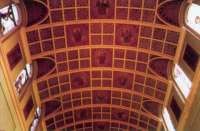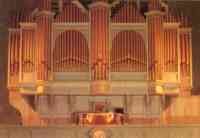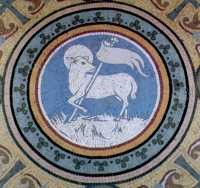 St. Joseph’s Church is a harmonious blending of the Romanesque and Byzantine styles, and was designed by the architect Albert Vicars of Somerset Chambers, 151 Strand. It is a listed building, described by English Heritage as outstanding. The church is 146 feet long and more than 55 feet wide. The dome is estimated to weigh, with its supporting brickwork, 2000 tons. The dome, of copper with a patina of green, is 130 feet above the level of the cross of St.Paul’s, and can be seen from such varied vantage points as a train returning to King’s Cross, Hampstead Heath and indeed, from far across London. While the dome may be the most familiar feature, the church itself would repay a visit, with its Italian interior and serene spaciousness.
St. Joseph’s Church is a harmonious blending of the Romanesque and Byzantine styles, and was designed by the architect Albert Vicars of Somerset Chambers, 151 Strand. It is a listed building, described by English Heritage as outstanding. The church is 146 feet long and more than 55 feet wide. The dome is estimated to weigh, with its supporting brickwork, 2000 tons. The dome, of copper with a patina of green, is 130 feet above the level of the cross of St.Paul’s, and can be seen from such varied vantage points as a train returning to King’s Cross, Hampstead Heath and indeed, from far across London. While the dome may be the most familiar feature, the church itself would repay a visit, with its Italian interior and serene spaciousness.
 One of the key features inside the church is the baldachino, or canopy, over the high altar. The altar piece is made from Sicilian marble, and the cylindrical steel safe of the tabernacle is from the 1861 church. A comparison of the records shows that the surrounds and the dome of the tabernacle are an exact copy, in marble, of the original wooden surrounds, found not only on the first altar in this church, but even in the previous church of 1861.
One of the key features inside the church is the baldachino, or canopy, over the high altar. The altar piece is made from Sicilian marble, and the cylindrical steel safe of the tabernacle is from the 1861 church. A comparison of the records shows that the surrounds and the dome of the tabernacle are an exact copy, in marble, of the original wooden surrounds, found not only on the first altar in this church, but even in the previous church of 1861.
The mosaic pavement in the sanctuary is made from material taken from the bed of the River Severn, and is reputed to be more durable and more costly than marble.
 Another feature is the hand painted, segmental, vaulted ceiling painted by Nathaniel Westlake in 1891. It is said by some art critics to be one of the finest of Westlake’s work. Each segment of the ceiling has an angel carrying a scroll with a verse from the Te Deum, the church’s great hymn of thanksgiving. Beginning over the organ gallery and ending at the entrance to the sanctuary, the whole hymn is reproduced. There are 250 panels in all and the ceiling is 53 feet high from floor to internal apex.
Another feature is the hand painted, segmental, vaulted ceiling painted by Nathaniel Westlake in 1891. It is said by some art critics to be one of the finest of Westlake’s work. Each segment of the ceiling has an angel carrying a scroll with a verse from the Te Deum, the church’s great hymn of thanksgiving. Beginning over the organ gallery and ending at the entrance to the sanctuary, the whole hymn is reproduced. There are 250 panels in all and the ceiling is 53 feet high from floor to internal apex.
 The church has a fine four-manual organ built by the famous organ builder, William Hill & Sons. Acquired around 1947, it was installed as a memorial to members of the parish who had lost their lives in the Second World War. There is a dedication plaque to this effect in the Church. Recently awarded a Grade I Certificate by the British Institute of Organ Studies, it is described as ‘a rare example of an instrument by Hill & Son 1898, in original condition’. We are currently engaged in a work of refurbishment and continue to enjoy the improved quality of the organ as this work progresses. Donations are welcome!
The church has a fine four-manual organ built by the famous organ builder, William Hill & Sons. Acquired around 1947, it was installed as a memorial to members of the parish who had lost their lives in the Second World War. There is a dedication plaque to this effect in the Church. Recently awarded a Grade I Certificate by the British Institute of Organ Studies, it is described as ‘a rare example of an instrument by Hill & Son 1898, in original condition’. We are currently engaged in a work of refurbishment and continue to enjoy the improved quality of the organ as this work progresses. Donations are welcome!
